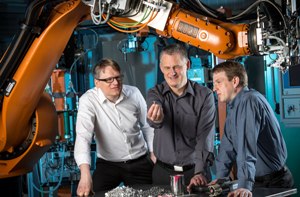May 23 2014
In industrial production, bonding plays an increasingly important role. Researchers have now succeeded in separating the processes of applying the adhesive and the actual joining, which opens up a new world of applications.
 The prize-winning team: Dr. Matthias Popp, Prof. Dr. Andreas Hartwig and Andreas Lühring. © Dirk Mahler/Fraunhofer
The prize-winning team: Dr. Matthias Popp, Prof. Dr. Andreas Hartwig and Andreas Lühring. © Dirk Mahler/Fraunhofer
Adhesive bonding technology is an effective and inexpensive means of seamlessly joining two parts, even two made of different materials. Especially in lightweight construction, adhesive bonding is the preferred technique because many of the materials used can hardly be joined otherwise. However, since liquid adhesives need time to cure, they cannot be applied in every production step. In hopes of finding a way to eliminate the need for regularly applying liquid adhesive while joining fasteners, the automotive supplier STANLEY Engineered Fastening - Tucker GmbH in Gießen turned to the researchers at the Fraunhofer Institute for Manufacturing Technology and Advanced Materials IFAM in Bremen. Their solution was a two-step process in which adhesive is initially deposited on one of the parts and then dried to form a non-sticky layer. During a subsequent production step, the adhesive is hardened and the two parts are bonded together.
Although two-step bonding techniques aren’t new – early postage stamps were coated with an adhesive that would only stick to envelopes once moistened – using them for industry is. Fraunhofer IFAM researchers have successfully developed the technique to allow for a high-strength adhesive bond suitable for industrial use – no easy task, since the adhesives must fulfill different and sometimes contradictory requirements. “Once the adhesive is applied, it can’t be tacky and it has to withstand long storage times,” explains chemical engineer Andreas Lühring from Fraunhofer IFAM. But the adhesive has to do more than that. “The adhesive also has to be very reactive and harden quickly during joining.” The researchers’ concept combines resins and hardening agents that melt at different temperatures. “We use micro-dispersion to finely distribute hardening agents with considerably higher melting points throughout the resin base,” adds Professor Andreas Hartwig.
The resulting reactive, hot melt adhesive is used in the manufacture of fastening bolts, for instance. First the material is heated and then applied onto the fastener. After it cools, it solidifies again. The fastener can then be transported and stored without difficulty. To harden the actual adhesive, it must be heated to more than 150 degrees Celcius in a controlled way. “Only then is the actual hardening agent melted and the adhesive activated,” explains Lühring. In this way, two parts can be bonded to each other within seconds.
“There is one disadvantage to reactive adhesives like these – they can be stored for a long time, but not indefinitely,” says Dr. Matthias Popp, group manager at Fraunhofer IFAM. That’s why the researchers had added an additional, visual means of monitoring the adhesive – if the substance has lost its functionality, it changes color.
These pre-applicable structural adhesives (PASA®) are also suitable for other applications, including a variable “construction kit” that offers adhesives based on different materials and hardening principles. The IFAM experts have altered the composition of the adhesives so that they yield the best possible productivity and characteristics for a wide variety of applications. For this development, Andreas Lühring, Andreas Hartwig and Matthias Popp received one of this year’s Joseph von Fraunhofer prizes.